#isuzu i-mark
Explore tagged Tumblr posts
Text




Isuzu CO-A, 1983. A targa-roofed concept presented at the 25th Tokyo Motor Show that previewed the second generation Gemini/i-Mark. The concept was characterised as a ‘communications capsule for open-air motoring’. Thought the JT150 series Gemini/i-Mark was designed by Giorgetto Giugiaro the CO-A was designed at Isuzu
#Isuzu#Isuzu CO-A#Isuzu Gemini#Isuzu i-Mark#concept#prototype#design study#open roof#targa#roof#1983#25th Tokyo Motor Show#show car
283 notes
·
View notes
Text
STOP IT THOSE ARE THIRD GENERATION OPEL KADETTS >:( IT EVEN SAYS SO ON THE LAST ONE'S PLATE! LOOK! EVEN WIKIPEDIA SAYS-
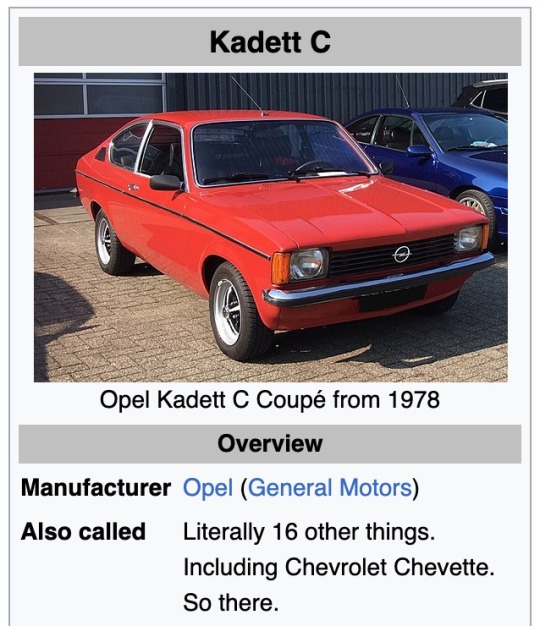
Hm. I guess the world has a lot of very different views on what this is called.
You can just feel a weird story coming, can't you. And indeed, our story starts in '73, with the other war America is losing.

The United States are having an existential crisis over the discovery that oil is a finite resource, the hours spent lined up in front of starving gas stations have given Americans time to realize cars that use less of it are neat, so their own country's cars are getting positively barbecued by 'imports', i.e. cars made abroad. Some could argue it took 'domestic' brands around a decade to cobble together decent competition, and in that timespan foreigners were left free reign to gather an unprecedented foothold - American brands would never return to their domination of their home market. The local automotive output was so dire they became known as "malaise era" cars: the larger offerings that practically symbolized the country got shrunken in size and neutered in sportiness to cope with the wimpier engines caused by the new emission standards, and, while the foreigners moved ungodly numbers of the fuel efficient small cars they'd been making all along, yankees were pathetically scrambling to figure out what the hell 'small car' meant. And here's a hint: if you're bragging about how large it is you've not got it yet.

Oh, and it gets worse! But to learn just how much, since even those familiar with my engine layouts post may not have a sense of scale for engine size or even know precisely how it's measured, we must make a brief stop at the explanation station! Choo Choo! The combustion chamber, the volume above the piston in which the combustion happens, shrinks and expands as the piston goes up and down its travel (whose length, you'll love this one, is called 'stroke'). The change in volume between the top and bottom of the cylinder's stroke, aka the volume of air the cylinder's movement displaces, is called cylinder displacement. Add up the displacement of every cylinder and that's your engine displacement! See? That was easy!

As this stolen and pefrectionistically tweaked graphic points out, displacement is expressed in two ways: - cc, or cubic centimeters - ci, or cubic inches While in ci even large displacements remain in the hundreds, in cc even small displacements reach the thousands, so what in ci is a 250 engine in cc would be a 4096 engine, which really lacks a ring to it. Usually, then, such an engine would be called a 4.1, being pretty much 4.1L because 1L is 1000cc - how cool is having a measurement system codified by people who actually knew what they were doing? Really guys you should give metric another shot sometime.
And now, an example for scale: I happen to own one of the small cars that was whipping yankee ass the hardest (bar perhaps the Viet Congs' jeeps) - a first generation Volkswagen Golf, that reached their shores as Rabbit. It was sold with four cylinder engines, the wimpiest -that would be mine- a 1.1L, the mightiest a 1.6 - and the spicy sporty version, the GTI, with its splitter and wider fenders and sick ass wheels made out of the P of tire supplier Pirelli...

...that little riot, in its last years, got upgraded to -huzzah- a 1.8!
The Pacer, meanwhile?

Okay, it was also offered with six cylinder engines as small as 3.8L -not even four times the size of mine!- and the V8 was just for those who wanted something faster. Which made me wonder: if the GTI hit 100 km/h (that's 0-60 for you yankees) in 8 seconds, what'll the V8 Pacer's time be? And so I looked it up, got lost in laughter, and desperately looked for other figures because they cannot possibly be talking about the V8, and then realizing that no, the V8 really did 0-60 in fourteen seconds, and laughing for other minutes.
I could bring more examples, but in short, to call the American small car offerings especially inadequate would be charitable. But what if they didn't try to make a decent small car? Wouldn't it be better to just let the foreigners figure it out, and then ship some units over to sell under a brand of their own? Well, that's the idea behind captive imports, the name given to vehicles born through this specific form of badge engineering. And what better foreign manufacturer for General Motors to hit up than Opel, the German vehicular colossus that GM happened to own and already have been importing cars of, selling them through Buick dealers! So essentially, GM needed dear god anything acceptable badly, and decided to bring over what someone else had cooked up and spotted the right business from inside the house. However, the Steamed Hams parallels end here, because they openly sold it as the Opel Kadett it was. While it still was.
But due to that whole crisis thing, the Deutschmark rose in value relative to the American dollar (so, for the economically inept, the same amount of Destumchrak cost more dollars to obtain) such that, while Opel asked for the same Dusthemcrhak for each car, the cost to Buick rose past sustainability. And, to save you the short story about the boss's lover answering the phone, they did what you do when a supplier's nationality causes their product to skyrocket in cost: find a supplier elsewhere. See, normally badge engineered cars can be split between those jointly developed by two manufacturers and ones merely picked up by another manufacturer after the fact. This, instead, was both, since Opel developed it with help from Japanese manufacturer Isuzu, which themselves made and sold it as the Isuzu Bellet Gemini at first and later just Isuzu Gemini. So Buick just started buying units from them instead. However, to denote that the car was the same but different (read: more cheaply built) they cobbled up the name Opel by Isuzu. After a year, someone must've realized that name was ass and demanded it be changed - presumably forgetting to specify to replace it with a non-ass one, since it got changed to Buick Opel.
And no one gave a shit. Because really, no one gave a shit about the car in general, reserving their attention for more established alternatives like the Toyota Corolla or the aforementioned Rabbit. So Buick devised a cunning strategy: the Buick Opel 5 Car Showdown - also known as possibly the hardest I ever laughed at automotive advertising, and pretty much the only reason I actually made this whole post.
Essentially the idea was to evaluate the Buick Opel in various showdowns against compacts people actually gave a shit about and at the end of it score them overall. Thing is, the problem with such a test is that it has to be clearly impartial for its conclusions to be worth anything. "Oh, so was it, like, just so laughably rigged?" No. Exactly the opposite. It was laughably not rigged.


Yeah.
To be fair, there is an area in which it came out on top, and the ad frames this as a result that proves it's a car worth considering just as much as every other. Really, it's hard not to be endeared by the candid honesty of this copy.


Of course, none of this makes it much less hilarious to imagine whoever worked at marketing for Volkswagen grabbing the paper and finding out General Motors had bought a three page ad to tell the world the Rabbit was better than their own car.

Easiest paycheck of their fucking life.
Okay, now that you've seen the ads about how General Motors said my car is better than theirs, you can go. Or, if "GM then renamed the car Isuzu I-Mark" sounds like riveting content to you, hop under the Read More, because hoo boy is there some weird shit.
One place where our poor little car fared better was Australia, where it was sold as the Holden Gemini, since Holden, as I hinted at previously, was the Australian arm of General motors, just like Vauxhall is the British arm of it. Vauxhall has for almost all its life just been a badge they slapped on Opels, and Holden has been that to varying extents, but due to the Australian obsession with a type of car that just doesn't sell elsewhere they've always had some bespoke stuff going for them. The tables turned this time, it would seem, since the Holden Gemini was just a rebadge (albeit of the Isuzu model) and the Vauxhall Chevette was a different model, with a nick of unique styling about it in the form of a different front...

...perhaps more reminiscent of the Chevrolet Chevette sold in North America.
Wait, why's the name in green? Was General Motors selling Americans the same car twice? Well, not quite.

Though built upon the Kadett's platform, this is a somewhat different car. And we could argue about whether it's fair of Wikipedia to cite that under a different name the Kadett was known by. We could, if this was what it was included over. But it wasn't. Because the Brazilian Chevrolet Chevette was the same car. In the first four pictures of the original post you can faintly make out a Chevette badge next to the right headlight. Here's a picture of its restyling and HOLD ON A SECOND

Yeah, these cars were a big cauldron of mess. For another example, since Holden wanted to sell wagons and panel vans, which Isuzu didn't make, those were derived from, respectively, the Opel Kadett wagon and the Vauxhall Chevette panel van, onto which Gemini fronts were grafted.
And that's not even all the places these were made and sold in! South Korean manufacturer Saehan struck a deal with GM to sell these as Seahan Geminis (and exporting them as Saehan Birds), and when they updated it the name changed to Saehan Maepsy, which when Saehan got bought by bigger South Korean manufacturer Daewoo became Daewoo Maepsy, which later got updated again into the Daewoo Maepsy-na (new)...

and GM Argentina made and sold the car as the Opel K-180.

And then in 1992 it got even weirder, when Brazil made a slight update aimed at the Argentinian market and called it GMC Chevette.

You know. GMC. The truck/SUV/van/bus brand that, in its 112 years of existence, has never been stamped on a car before or since the 3 year run of this thing. Imagine finding out that, for three years in some relatively random country, Ferrari sold a pickup. It's starting to feel like someone warned automotive manufacturing the world over of approaching alien invaders that could only be warded off by enough names for the Opel Kadett.
Unfortunately, the Wikipedia page foregoes mention of the heroic efforts of Uruguayan operation Grumett - Yah! Here's an estate called Grumett 250M Rural! Yah! Here's an update of it called Grumett Gazelle Estate! a coupe called Grumett Coupe! Yah! Here's an update of it called Grumett Sport Coupe! Yah! We export these as Grumett Condors! Yah! Take that, extraterrestrial plurikadettonomophobes!
This mess of different manufacturers involved meant that all those different names, once the manufacturers worked on updating and replacing the model, ended up on completely different cars!
Here's a 1980 Opel Kadett/Vauxhall Astra...

...here's a 1983 Chevrolet Chevette...

...here's a 1984 Daewoo Maepsy-Na...

...here's a 1984 Opel Kadett...

...here's a 1985 Isuzu/Holden Gemini...

...here's a 1990 Isuzu Gemini...

...and here's a 1992 GMC Chevette.

You somehow get the vibe that Argentina wasn't doing quite as well as Japan.
So, this was the story of a world car and the ways various parts of the world interpreted it. And if you thought it was excruciating to read, try writing the damn thing. Not just in terms of the sheer work of getting any sort of narrative flow going, it was a mess to research - the info could get unclear or even contradicting, "it's more complicated than that" was a common refrain, and there seemed to be a near endless supply of tidbits that- wait, what's that? It's too big for a bird, too fast for a plane... oh no... it's a stereotypically-shaped flying saucer!!!
*the unrealistically humanoid aliens dive towards the helpless crowd around me, but as my eyes light up with the fierce courage of the chosen one, I rush towards the oncoming ship against the wave of people I urge to stand back, and when it seems close enough, I climb atop a conveniently placed statue of a riderless horse and fill my lungs at peak capacity*
IN MALAYSIA IT WAS CALLED OPEL CHEVETTE!
*the ship engulfs in flame, loses control and crumbles gracelessly onto the street and surrounding buildings, causing four debilitating injuries and 37 first degree burns*
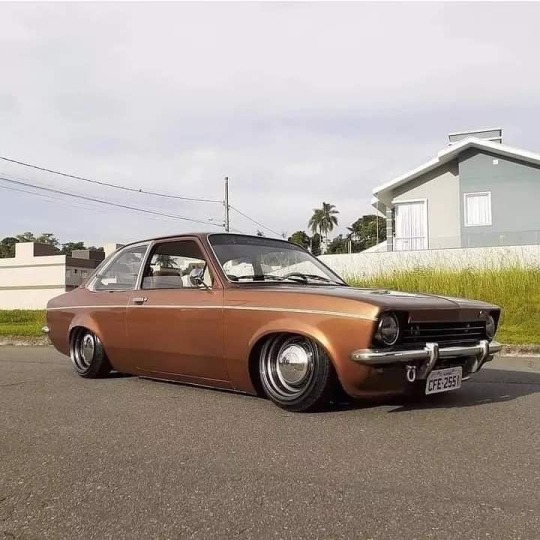
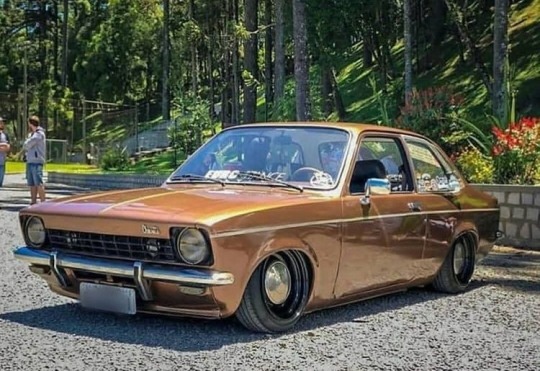
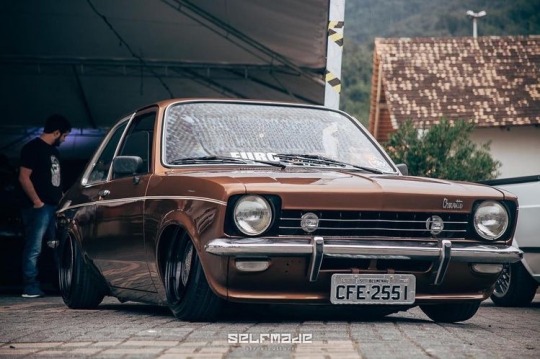
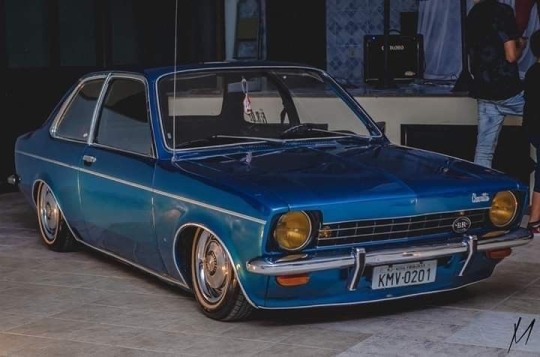
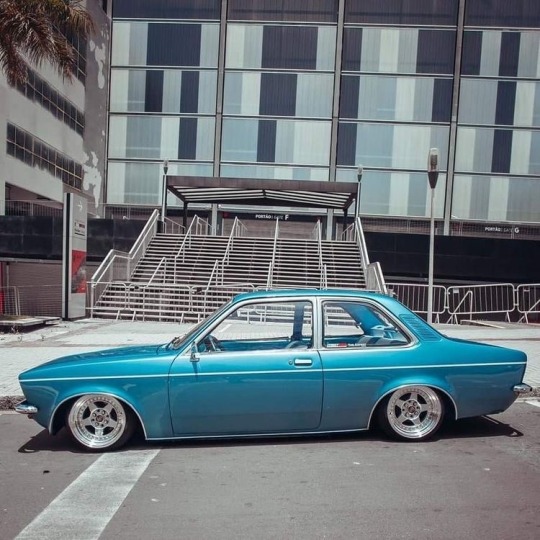


Chevy Chevette Coupe
#oh no the tags show up under the post even if you don't click the read more they're gonna spoil the post#quick if you think you stand a chance of giving a shit and haven't opened the read more do it right now before you read these next tags#chevrolet chevette#opel kadett#amc pacer#volkswagen golf#volkswagen rabbit#isuzu bellet gemini#isuzu gemini#opel by isuzu#buick opel#toyota corolla#isuzu i-mark#holden gemini#vauxhall chevette#saehan gemini#saehan bird#saehan maepsy#daewoo maepsy#daewoo maepsy-na#opel k-180#gmc chevette#grumett 250m rural#grumett coupe#grumett sport coupe#grumett condor#vauxhall astra#opel chevette#i am very glad they increased the max number of tags on a tumblr post to 30#because that's exactly how many these are
152 notes
·
View notes
Text
Isuzu UTE Australia's I-VENTURE Club Marks 10 Years of Success
Isuzu UTE Australia recently commemorated the tenth anniversary of its I-VENTURE Club with a special two-day event held at the popular 4WD park, Gordon Country, in Queensland. Launched in 2015, the I-VENTURE Club (IVC) was designed to provide Isuzu vehicle owners with opportunities to explore their vehicles’ off-road capabilities while enhancing their towing and off-road skills, all under the…
0 notes
Text
Breaking Down on the Road? Here’s What to Do Immediately

For truck drivers, breaking down mid-journey is a frustrating and potentially dangerous experience. Whether you’re driving an Isuzu truck or another commercial brand, knowing what to do during these moments can save time and ensure safety. Here’s a guide for handling breakdowns efficiently, minimizing stress, and getting back on the road quickly.
Stay Calm and Assess the Situation
First things first: don’t panic. Breaking down on a busy highway or rural road is overwhelming, but staying calm allows you to think clearly. Assess the truck's condition and determine whether it’s safe to stay where you are or move to a safer spot.
Look out for obvious issues, such as flat tires, smoking engines, or leaking fluids. If you suspect a serious issue, it’s best to call a reliable Mobile Truck Repair service like Menendez Roadservice LLC.
Secure Your Truck and Alert Other Drivers
Once you’ve assessed the situation, turn on your hazard lights. This alerts other drivers and improves visibility. Use reflective triangles or flares to mark your truck's location, especially if you’re stuck on a dark or narrow road. Keeping safety gear on hand is a must for every truck driver.
If your Bobcat Tires are damaged or another tire issue occurs, avoid driving further. Continuing to drive on a damaged tire can worsen the problem.
Contact Professional Assistance
Calling a trusted Truck Repair Shop is essential when a breakdown goes beyond what you can fix yourself. Mobile services are especially useful when you’re stranded. Technicians from Menendez Roadservice LLC can handle on-the-spot repairs, saving time and towing expenses.
For Isuzu truck drivers, seeking specialized repair services ensures the job gets done correctly. Whether it’s a blown tire or engine trouble, our mobile repair team has you covered.
Prepare for Future Breakdowns
After you’ve resolved the immediate problem, take steps to prevent future breakdowns. Regular maintenance, such as tire inspections and fluid checks, keeps your truck in top shape. Investing in high-quality parts, like Bobcat Tires, minimizes the risk of sudden failures.
Keep an emergency kit on hand with essentials like water, non-perishable snacks, a flashlight, spare fuses, and a basic toolset. These items are lifesavers during unexpected stops.
Why Choose Us?
When it comes to truck emergencies, Menendez Roadservice LLC is the go-to provider. Here’s why we’re trusted by fleet managers and drivers:
24/7 Service: We’re available day and night for Mobile Truck Repair emergencies.
Specialized Technicians: Our team handles brands like Isuzu, ensuring high-quality repairs.
Wide Range of Services: From Bobcat Tires to engine repairs, we provide comprehensive solutions.
Rapid Response Times: We prioritize getting you back on the road quickly.
Affordable Rates: Quality doesn’t have to break the bank.
Reliable Expertise: Years of experience make us the best choice for all your trucking needs.
FAQs
1. What should I do if I experience a tire blowout near Rockville?Immediately reduce your speed and pull over to a safe spot. Call a Mobile Truck Repair service to replace the tire.
2. Do you provide services for Isuzu trucks in Annapolis?Yes, we specialize in servicing Isuzu trucks and offer quick roadside repairs for various issues.
3. Can you handle Bobcat Tires for heavy-duty trucks in Greenbelt?Absolutely. We offer repairs, replacements, and maintenance for Bobcat Tires and other specialty options.
4. How can I prevent frequent breakdowns in Laurel?Regular inspections, fluid checks, and timely maintenance at a trusted Truck Repair Shop reduce the chances of unexpected issues.
5. What tools should I carry for emergencies in College Park?Keep a basic toolset, reflective triangles, spare fuses, and a flashlight in your truck for added preparedness.
6. Is mobile repair faster than visiting a repair shop in Bowie?Yes, Mobile Truck Repair eliminates the need for towing and provides immediate on-site assistance, saving both time and money.
Contact Menendez Roadservice LLC
Handling truck breakdowns doesn’t have to be stressful. Whether you need Mobile Truck Repair, new Bobcat Tires, or assistance with your Isuzu, our team is here to help.
Menendez Roadservice LLC - Commercial Truck Tire Service in Bowie, MD
Address: Bowie, MD Phone: (240) 601-9664
Call us anytime for dependable roadside assistance and keep your truck running smoothly!
0 notes
Text
Toba, Japan
July 1, 2023. (Oh - I am always behind!)
We left Tokyo on the Shinkansin bullet train headed to Nagoya. The train had many stops but each time we would pull out of the station and GO! The ride was amazingly smooth and the seats were roomy and of course everything was clean - and I mean CLEAN!


The Japanese people are very polite and bow to each other upon meeting or greeting and before leaving. The conductor would enter the car and bow then before he left the car he would turn face us and bow before exiting.
Mark said an unplanned good-bye to his cane as he exited with all our luggage but without the cane. We had only 50 minutes to get our food (bento boxes) and get to our next train - so it didn't cross his mind until too late. (No worries - he has a new one with a much prettier handle.). The store we visited to buy our lunch has shelf after shelf of bento options.

In Nagoya we exited the Shinkansin and boarded an "express" train to Ujiymada. This express train is part of the general transportation system and we used our subway pass to access this train. This part of the trip also had many stops and we enjoyed seeing the countryside - something that could be kinda' nauseating at 190 mph. The train was smaller but just as clean.
Our new location is mountainous, lush and very different from the massive city of Tokyo. We are seeing little villages, lots of rice fields and many tiny little cemeteries. Cremation is standard practice here so the cemeteries are compact but the headstones impressive.

A bus was awaiting our arrival and we boarded it and traveled about 30 minutes to the Ise Grand Shrine. The Torii gate designates a sacred area with a shrine where believers can go to pray. The Torii Gate in front of this park was HUGE
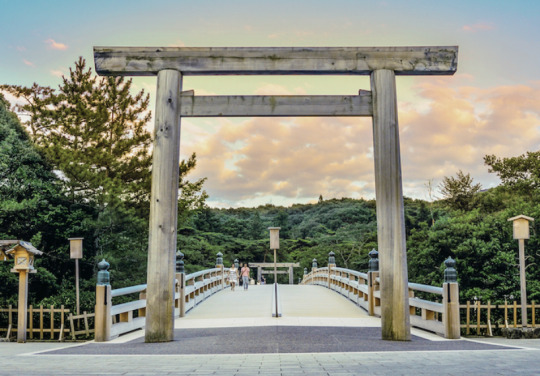
The Naiku and the Geku shrines dedicated to the Shinto kami, Amaterasu, kami of the sun. We visited Naiku.
The Shinto shrines were beautiful and they were in this gorgeous park with forested with ancient trees. There are specific mid year rites that take place on June 30 and July 1 - so the place was hopping. Shinto is not a religion but a more of philosophy. Shintoists believe that there are spirits in everything called "kami" - some good and some bad. When a Shintoist goes to the Shrine he prays that the bad spirits will be diminished and the good spirits will guide his life and the lives of people he loves
Here is the buzz about this shrine from the website: "Around 2000 years ago the divine Yamatohime-no-mikoto, daughter of the Emperor Suinin, set out from Mt. Miwa in modern Nara Prefecture in search of a permanent location to worship the goddess Amaterasu, wandering for 20 years through the regions of Omi and Mino. Her search eventually brought her to Ise, in modern Mie Prefecture, where she is said to have established Naikū after hearing the voice of Amaterasu saying "(Ise) is a secluded and pleasant land. In this land I wish to dwell." Before Yamatohime-no-mikoto's journey, Amaterasu had been worshiped at the imperial residence in Yamato, then briefly at Kasanui in the eastern Nara basin. When Princess Yamatohime-no-mikoto arrived at the village of Uji-tachi, she set up fifty bells to designate the area as enshrined for the goddess Amaterasu, which is why the river is called the Isuzu, or "fifty bells".
This is also amazing.... (lifted right from the Ise Grand Shrine website)
"The old shrines are dismantled and new ones built on an adjacent site to exacting specifications every 20 years at exorbitant expense, so that the buildings will be forever new and forever ancient and original. The present buildings, dating from 2013, are the 62nd iteration to date and are scheduled for rebuilding in 2033. The twenty-year renewal process is called the Shikinen Sengū. This happens all over - not just here - FYI. (There will not be a test on this...)
The team which builds the shrine is typically formed around a few factors. Since many of the building techniques haven't changed since the creation of the Ise Shrine, the workers who are hired to build the shrine must be skilled in specific techniques. Power tools are not allowed within the area of the shrine, which means that skilled artisans and carpenters known as miyadaiku are necessary in the construction process. The unit of workers is also organized around relative skill levels, and less experienced workers will work on smaller tasks than more experienced workers. The importance of hiring specifically local artisans has decreased throughout time, for the pool of available miyadaiku has thinned out."
Me again...There are festivals celebrating many steps of the dismantling and rebuilding. Finding the correct materials is a process that begins 40 years before as some of the materials must be aged. Fascinating! This process may be used for other shrines - but none were mentions - just this one.

This is my pic and it looks foggy - BUT it was so hot and muggy that I couldn't wear my glasses and even my phone lens were fogged. PHEW! But despite the fog - can you imagine taking this down!?!??!
Despite the beauty of the place - it was here that someone could have made a comedy video about me and Mark.
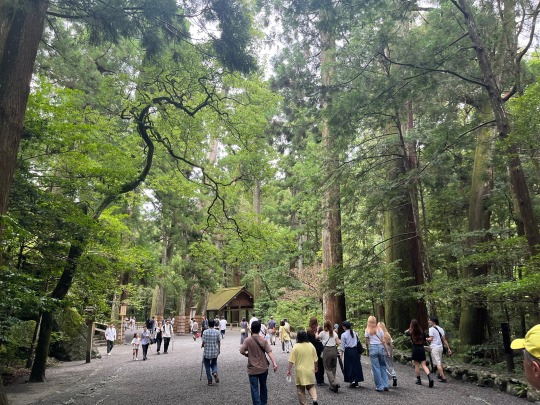

This park is big and the paths are gravel - which are hard to walk on for everyone - but for someone who using a cane it is even harder. For someone using a cane who has lost his cane - a flipping nightmare. BUT - they have free wheelchairs - and WHAT?!?!? - they are electric. OMG!! LUCKY US!
So Mark and Jay get wheelchairs - BUT the damn control is in the back and it is a joystick. Carol, Jay's wife, got the hang of it immediately - but I couldn't - AND to make things worse I started laughing and laughing and laughing. I couldn't go straight to save my life and poor Mark looked like he was riding a bucking bronco. Finally he could take it no more and got out and used it for balance and drove it himself. I tried several more times -and there were times I did OK - but... OMG!!! Anson took a turn and gave Mark a better ride - but by the time we needed to get back on the bus , Mark was thrilled to have that adventure in the rearview mirror. We all have our strengths and using a joy stick is not mine! Sorry Mark!

On to our next adventure...
We arrived in Toba and although I should have known it by looking at the map - I didn't realized it was a seaside resort.

Even more surprising was how large and beautiful each of our rooms were. Anson's room had a beautiful deck overlooking a rock garden and our room overlooked the ocean and a small harbor. The photo below on the right is from our room and from the left is from Anson's room. SWEET!!!


We are staying at the Todaya Hotel which houses a several restaurants. I will say that the food was not only edible art but also delicious. They also have onsens (public baths) in many flavors: Single private - small groups or the big party size - which is outdoors. The boys tried most of them. OF COURSE we had to dress in our yukatas to get ready for the big soaking relax in your birthday suit!


Anson-san in his first onsen - private, please. No photos in the places your share!

Most of our group was in to it!!

We are having a great time in Japan.
Stay tuned!
1 note
·
View note
Photo

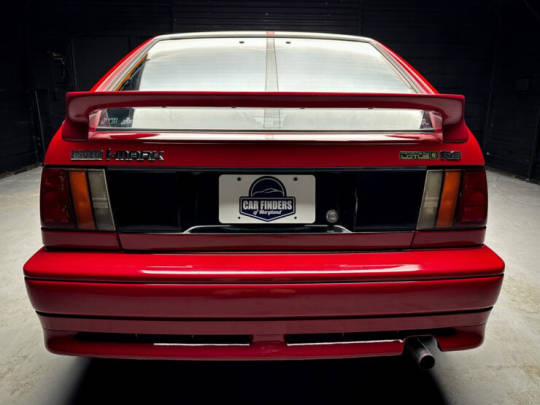
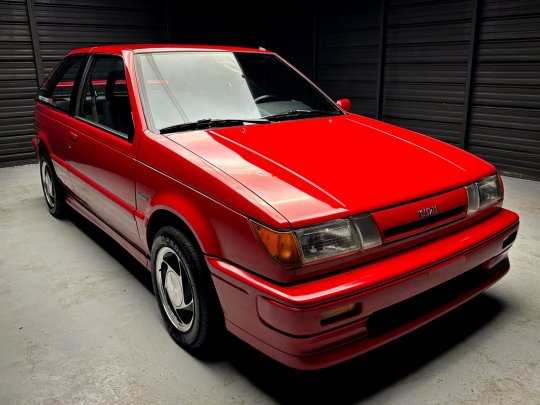


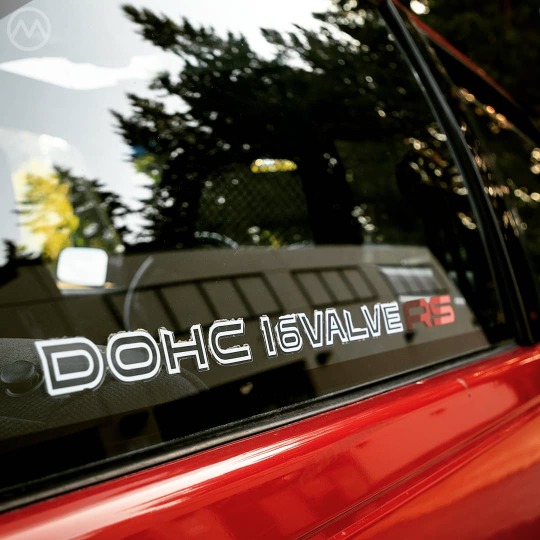
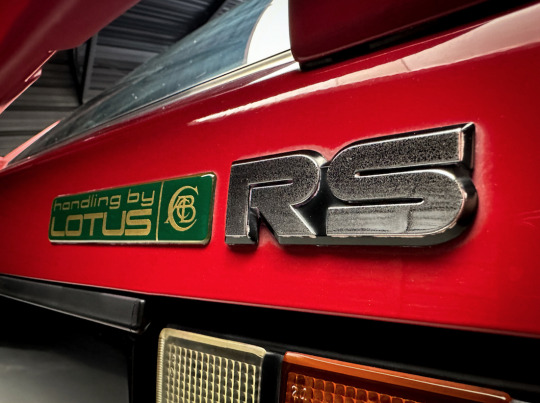
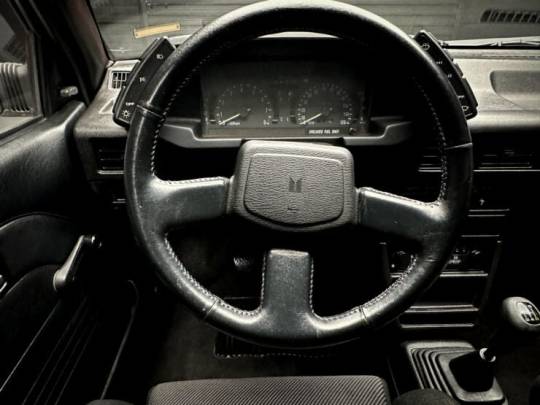
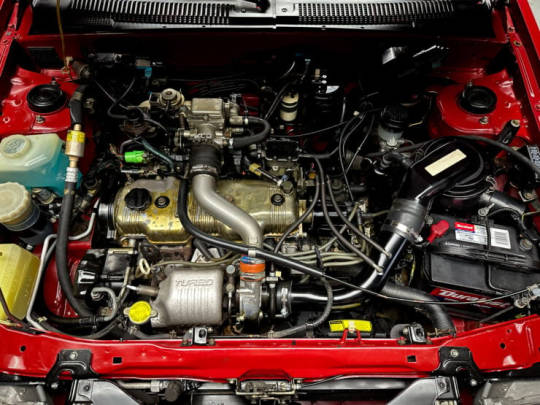
Isuzu I-Mark Turbo RS
This is the Isuzu I-Mark Turbo RS, it’s a little-remembered hot hatch from the golden age of turbo that was designed by Italian great Giorgetto Giugiaro, it had suspension tuned by Lotus, and it was built by Isuzu in Japan.he Isuzu I-Mark Turbo RS was the top of the line model in the second generation Isuzu Gemini model family, a model family that had been initially designed by Giorgetto Giugiaro. After Giugiaro had finalized the styling it was sent to GM for approval, and this is where things began to go awry. GM made a few relatively minor changes to the design but no one at Isuzu or GM ran the changes by Giugiaro, when he learned what had happened he refused to have his name associated with the car and cut all ties with Isuzu. He wouldn’t publicly admit to having designed the car until a decade after it went out of production. As a result, some have called it “the forgotten Giugiaro.” This hiccup aside, the I-Mark Turbo RS was a remarkable performer by the standards of the time, most of the original Giugiaro styling remained, and Lotus had been hired to fine-tune the suspension. This all resulted in a car with excellent performance, sharp handling, popular styling, and good fuel economy to boot.The car shared the same basic steel unibody as the standard I-Mark, the suspension had been completely reworked by Lotus with new springs, thicker sway bars, and tuned shock absorbers. Period ads for the car claimed it could achieve .79g on a skid pad, just like a Porsche 944.In the inline-four cylinder engine has a displacement of 1.5 liters, it has double overhead cams, four valves per cylinder, and electronic fuel injection. In standard trim it produced 125 bhp at 7,800 rpm and it could do the 0-62 mph dash in 8.1 seconds – not a bad time for a hot hatch in the 1980s.
46 notes
·
View notes
Text

1988 Isuzu I-Mark RS Turbo hot hatch
5 notes
·
View notes
Text
whenever i see a cute ship in an anime
the anime:

#i have so many on my list its not even funny#every fucking time hhhhhh#why do most sports anime have exclamation marks in them???#haikyuu#tsurune#free!#free#haikyuu!!#wave!!#wave#wave anime#yuri on ice#yoi#yuri on ice!#kuroko no basquet#kuroko's basketball#rinharu#reigisa#gou and isuzu#victuuri#prince of stride#pos#anime
85 notes
·
View notes
Photo



Isuzu Zero Door Concept, 1988. An open buggy fun-car based on the Giorgetto Giugiaro-designed second generation Isuzu Gemini/I-Mark
#Isuzu#Isuzu Zero Door#concept#prototype#buggy#beach car#1988#1980s#Isuzu Gemini#Isuzu I-Mark#open roof#fun car
102 notes
·
View notes
Text
There's a special power to telling a story. Putting things into a sort of sequential, narrative format lets you convince people of your belief, even if it's complete bullshit. For whatever reason, our entire species is hard-wired to believe a story that provides a concise, simple explanation for the way the world is. I'm sure you can think of ways to abuse this power; for me, I used my theatrical training to get discounts on cars. One day, it all went sideways on me.
I remember it like it was yesterday. Here I am, standing on the previous owner's lawn, looking over a Corolla FX16. There was no way I was going to pay full price for this vehicle - my religion forbids it. Scanning the area and the vehicle for weaknesses, I determined that this guy would probably bend over backwards for a sympathetic yarn. So I tried one on.
"You know, I grew up in an orphanage in Hong Kong," I lied blatantly to his face. "The last thing I remember was that the man who dropped me off was driving one of these. It seems crazy, but driving your Toyota helped me feel like I had some connection to my birth family, as vague as it was."
He was blown away, and started to ask some followup questions. I quickly lost track of which contradictions and bullshit I had already woven through, but any inconsistencies in my amazing rags-to-riches story were quickly wallpapered over because he Wanted To Believe Me. A deal was struck, and I got fifty bucks off because of my story (and also because the wheels were a little scratched.) What I didn't realize was that my lies would follow me home, unlike the muffler of the FX16 as soon as I revved the car up to 4500 rpm and side stepped the clutch coming out of the owner's cul-de-sac.
The next morning, the press was at my door. They wanted to hear about this amazing story, how an orphan had formed a multi-million dollar textile business and was living in such squalor so as to remain humbly approachable in the hope that his birth father may one day return. I was a little aghast that I had laid it on so thick for a mere fifty bucks off, but then I remembered that the previous owner didn't include the spare-tire jack with the car, so fuck him.
Here's the thing with lies: once you make one, it's really easy to make more. I faced the camera, and laid out another amazing yarn about my long-lost mother's car, a 1988 Isuzu i-Mark RS Turbo. If anyone had one of those, I cried for the news, then please let me have it for super fucking cheap.
They didn't even bleep out that last part, because a rugged, self-made industrialist like me could say what he wanted with no fear of reprisal.
9 notes
·
View notes
Photo

10 notes
·
View notes
Text
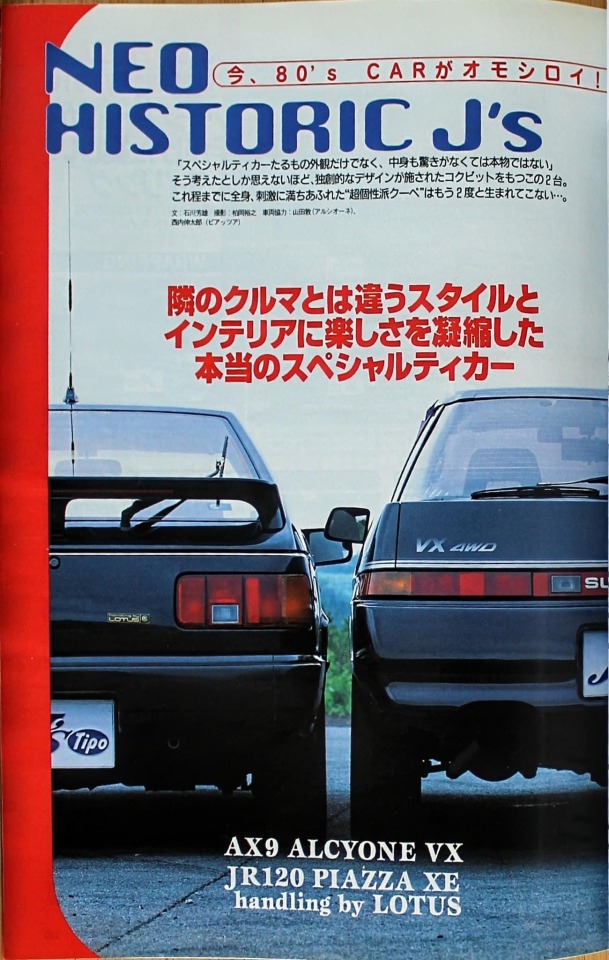
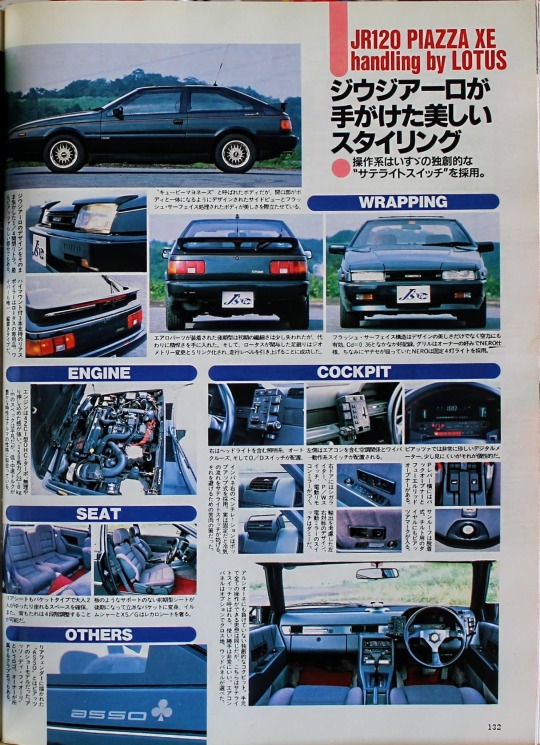
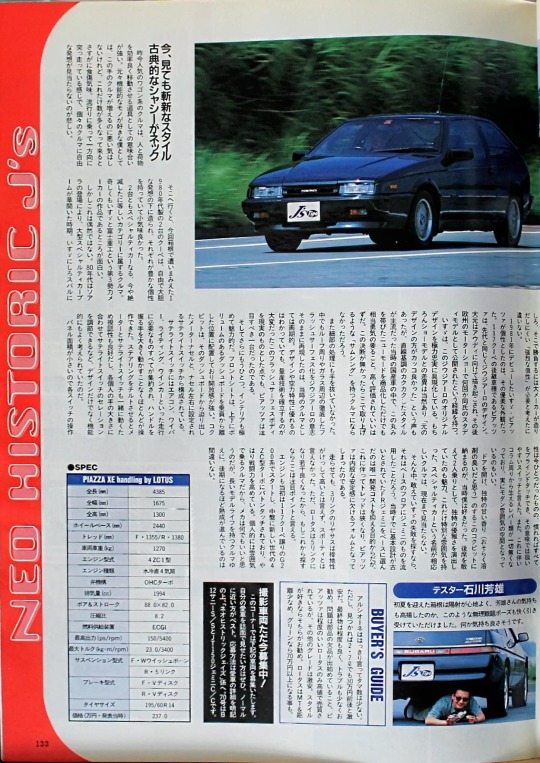
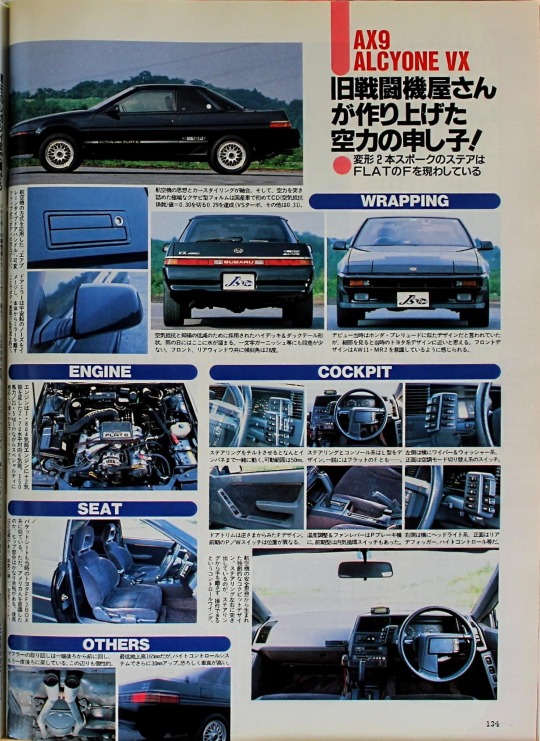
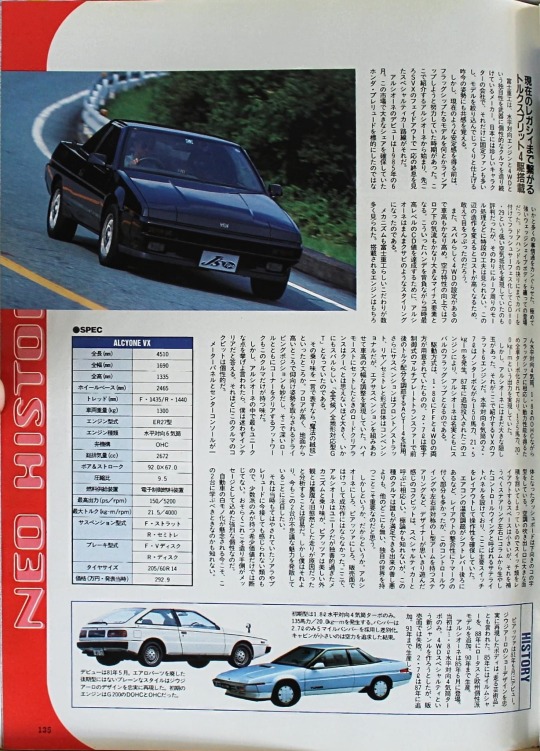
Now, 80's CAR is interesting! NEO HISTORIC J's
"A specialty car is not a real thing without surprises on the inside as well as on the outside." A “super-unique couve” full of stimulation from the whole body like this will never be born again.
Text: Yoshio Ishikawa Photo: Hiroyuki Kashiwaoka Vehicle cooperation: Atsushi Yamada (Alcyone), Shintaro Nishiuchi (Piazza)
A true specialty car with a style and interior that is different from its neighbors and packed with fun
AX9 ALCYONE VX
JR120 PIAZZA XE handling by LOTUS
PIAZZA
Beautiful styling by Giugiaro
The operation system adopts Isuzu's original "satellite switch".
WRAPPING
The body was called “Kewpie mayonnaise”, but the opening is a box.
Side view and flat design designed to become one with The body with a su-surface treatment accentuates its beauty.
Based on Giugiaro's design
1/4 opening and closing headlight covers which I made good use of.
Three support risers with high mount brake light
The spoiler is exclusive to Lotus.
is also a part of Piazza.
The late model with aero parts lost a little of the delicacy of the early days, but instead gained a fearlessness. And the suspension that Lotus was involved in changed the geometry and made it 5 links, and succeeded in raising the driving level.
The flash surface structure is effective not only for the beauty of the design but also for the aerodynamics. Cd=0.36 is a good record. The grill is NERO specification according to the owner's preference. By the way, Yanase's NERO uses fixed 4 lights.
ENGINE
The engine is a 4ZCI type OHC turbo. I have a strong feeling that I was forced into it. The specs of 150 horsepower/20 kg-m are mediocre, but the characteristics of rich low and medium speed torque match the character of the car
COCKPIT
On the left side are the switches for air-conditioning, including the air-conditioner, and wiper-operating system switches.
On the right is the lighting system including headlights, auto cruise, and O/D switch.
A digital meter, which is very rare in Piazza. It's a little hard to see, but that's what makes it unique.
The ventilation on the right side of the instrument panel uses a pop-up type. In fact, if it is fixed, the satellite switch will block the flow of cool air. It was a desperate measure to avoid it.
The right door has a cigarette lighter, P/W switch, and electric remote control mirror.
Symmetrical design considering export. The electric mirror switch is a dummy.
There is a back opener and a fuel lid opener next to the P lever.
The sunroof is removable. The dial for tilting also has the Piazza mark.
An original cockpit that is as good as Alcyone.
The idea that all operations can be performed at hand with is the same, but this is a satellite
called a switch. Very easy to use. air conditioner
Optional cloth and wood panels were available for the panel.
SEAT
The rear seat is also a bucket type and can accommodate 2 adults.
Make sure there is enough space for people to sit comfortably.
In addition, the backrest can be adjusted in 4 stages.
The early model seat without board-like support transforms into a splendid bucket in the late model. Irmscher and XS/G can have optional RECARO seats.
OTHERS
"ASSO" painted on the rear fender was Piazza's show model. The logo "Aso di Fiori" is also the name of the club to which the owner belongs.
A novel style even now
Classic chassis is the bottleneck
Wagon-type cars, which are popular these days, have a strong meaning as a tool for efficiently moving people and goods. As someone who likes functional things, I don't mind the increase in the number of cars like this, but when the number of cars increases this much, it's just a bit of a disappointment. It's sad that I can't find any free ideas for individual cars, as it seems that they are riding the trend and rushing in one direction.
When I went there, I saw two coupes made in the 1980s that I encountered in Hakone this time. They were built based on free and bold ideas, and each had a rich personality, which was refreshing.
Both cars belong to the almost extinct category of specialty cars. Interestingly enough, this is the work of the third power manufacturer, Isuzu and Fuji Heavy Industries.
But this is no coincidence. The 1980s was a time when a large-scale specialty car boom blossomed with the introduction of the Soarer. Isuzu or Subaru In order to compete there, they must have thought that a “strong individuality” that is difficult for large manufacturers to create was necessary.
The Isuzu Piazza, which debuted in 1981, was characterized by its elegant appearance. The Piazza, the successor to the 117 Coupe, was designed by Giugiaro, just like its predecessor. Originally drawn for Audi, it has been shown several times as his study model at European motor shows.
Isuzu has embodied this Giugiaro original design as faithfully as possible. Of course, there were some differences from the show model, and some people said that the original design was cooler. It takes a lot of courage just to commercialize the tinged new mode. It should be appreciated. Without this decision, the car wouldn't have had the "something" we're talking about here.
In addition, he did not cut corners in the processing of details. Above all, it was epoch-making for a car at that time that the roof and glass areas were completely recreated exactly as Giugiaro intended. The Piazza was a car worthy of attention for realizing the flush surface body, which had been difficult to establish for mass production, even though we knew that it had excellent design and aerodynamic characteristics.
And one more thing, the interior is extremely attractive. The front seats have a voluminous dashboard placed in a position away from the occupants, giving a strong sense of openness. The cockpit consists of a meter nacelle protruding from the dashboard and satellite switches set to the left and right of the nacelle.
The satellite switch has everything necessary for driving such as air conditioner, wiper 1, lighting, turn signal, etc., and most of them can be operated without moving the steering wheel significantly. When the steering wheel is tilted, the gauges and satellite switches move together. Visibility is good, and the serrations of the satellite switches can be adjusted according to the size of each individual's hand. It was taken.
Since the panel area is small, it is easy to operate each switch.
Although the functionality was not good enough, once you get used to it, you can touch everything blindly, and in that sense, it can be said that it is an easy-to-use switch. Also, along with this, there are no levers growing around the column, and it is nice that the space has a really modern atmosphere.
At the time, I loved opening the door and sitting in this cockpit with that unique sweet smell (I think it smelled like solvent). It is also attractive that the rear seats are two-seaters to create a unique elegance. Until now, no other car with such a special atmosphere has been found that deserves the name "specialty car."
In the midst of all this, if I were to look for Isuzu's fault, it would be the use of Gemini's for the floor of the base. The FR Gemini, whose basic design was already outdated at the time, was chosen to be the base for the sole purpose of keeping development costs down. It's gone.
Even when I ran it, the 3-link rear suspension could not be said to have high grounding performance, and it could not be said to be sporty. However, Lotus has improved a little since it has 5 links, so if you are looking for it from now on, you can say that this is a point to pay attention to.
The engine also started with the G200 series inherited from the 117 coupe, and in the middle stage, the new generation 4 ZC type turbo was touched, which also increased the competitiveness. Personally, I don't mind anything about the mechanicals because it's a car that I drive for the atmosphere, but since it's a car with a long model life, it's definitely matured as it gets older.
Tester Yoshio Ishikawa
Yoshio's feelings about the pleasant sunlight in early summer in Hakone
Was it uplifting?
I was able to receive it. Something feels good.
BUYER'S GUIDE
To put it bluntly, Alcyone doesn't have many balls. However, if you can find one, even a 2.7-liter bottle is very cheap at around 300,000 yen. The final product is in good condition, and there are few troubles. The problem is that parts are starting to be out of stock. In Piazza, only good Lotus cars are sold at high prices, but other grades are extremely cheap. If you like style, go for it. Lotus has less MT and distance, and greens can cost more than 700,000 yen.
We are currently recruiting photography vehicles!
We are looking for the following vehicles in this corner. If you want to show your favorite car in the magazine, please check it out. Close to normal is best. To apply, specify the details of your favorite car and contact the "Neo Historic Jays" section. No. 70 is B12 Sunny S/S and JT150 Gemini C/C.
AX9 ALCYONE VX
A child of aerodynamics created by a former fighter shop!
Deformation 2-spoke steering shows FLAT F
WRAPPING
Fusion of aircraft concept and car styling. In addition, the extreme wedge-shaped form that pursues aerodynamics is the first Japanese car to achieve a CD (air resistance coefficient) value of 0.29, which is less than 0.30 (0.31 for VS Turbo and others).
“Airbnb” that applies the system of aircraft
Lane type door handle. There is no unevenness of the body with the variable flap type.
Door mirrors highlight the nose of the spacecraft.
prevent turbulence on the body surface by separating the mirrors from the body.
High deck and ducktail shape adopted to reduce air resistance and intonation. Water collects here on rainy days. There is no step even for single garnishes. Both the front and rear windows have an inclination angle of 28 degrees.
At the time of its debut, it was said to have a design similar to the Honda Prelude. Looking at the details, it seems to be close to the Toyota design at that time. The front design seems to be conscious of the AW11 MR2.
ENGINE
The engine is a 2.7-liter horizontally opposed 6-cylinder engine with +2 cylinders added to the 1. 8L 4-cylinder engine. 150 Horsepower / 21.5kgm but suitable for specialty.
SEAT
The bucket seat is also similar to the Toyota FF2BOX series at that time. However, the hip part has a lot of room, probably because it was made with Americans in mind. The rear seats are oppressive and very narrow. Perfect 2+2
COCKPIT
When you tilt the steering wheel, the instrument panel moves with it. Movable range is 50mm
The steering and console system are L type
Zain. One theory is that it is a flat F.
The left side has a wiper and washer system, and the front has an air conditioning mode switch.
The door trim is an F design seen from the upside down. The position of the P/W switch in the previous term is different.
The temperature adjustment & fan lever is next to the P brake. The previous model also had a shy air circulation switch.
On the right side is the headlight system, and on the front is the rear defogger, height control, etc.
A unique cockpit design born from the concept of aircraft safety. Control wing protruding left and right of the steering wheel can be operated without taking your hands off the steering wheel.
OTHERS
The muffler is first turned from the back to the front and then put back again. This area is also unique.
The minimum ground clearance is 165mm, but the height control system increases it by 30mm. The car is terrifyingly tall.
Equipped with torque split 4WD that leads to the current Legacy
Fuji Heavy Industries is a manufacturer that continues to create unique cars with the uniqueness of a horizontally opposed engine and 4WD as weapons. It is a company with characters that are rare in Japan, and I can sympathize with the recent attitude of narrowing down and carefully finishing models that have many fixed fans.
However, there was a time when we were striving to create a lineup of flagship models before we achieved the stability we have today. Starting with the Alcyone introduced here, this is the specialty car route that ended with the SVX fadeout.
Alcyone debuted in June 1985. They probably targeted the Honda Prelude, which held a large share of the market.
It was introduced with an extremely strong wedge-shaped body that confounded many circumstances. Add a cover to the gouge of the door handle to create a flush surface and CD=0.29. Although it had a reputation for achieving a low air resistance of 2, there was no special ingenuity in the processing of moldings around the roof. I guess he deliberately closed his eyes because changing the fixtures around here would increase the cost.
Also, like Subaru, there is a 4WD setting, so the vehicle height is quite high. Airflow under the floor is also a significant negative factor in improving aerodynamic characteristics. In order to achieve the highest level of CD value at the time while carrying such a handicap, the Alcyone was styled like a wedge.
The mechanism also showed a lot of attention to detail typical of Fuji Heavy Industries. As well as the engine installed
Although it was a horizontally opposed 4-cylinder 1.8L 2 0HC, all cars were turbocharged to obtain the power performance suitable for the flagship, achieving 135 horsepower and 20.0kgm.
However, the Alcyone still had a big secret, and that is the VX flat-six engine introduced here. The horizontally-opposed 6-cylinder 2.7-liter engine produces 150 horsepower and 21.5 kgm despite being non-turbo. With this engine added in 1986, the Alcyone became Subaru's flagship in both name and reality.
As for the drive system, although both FF and 4WD were prepared for the 1.8 liter, the 2.7 liter adopted ACTI4, which adjusts the front and rear torque distribution with an electronically controlled multi-plate transfer. In addition, the suspension system itself was conventional with front/strut and rear/semi-trail, but combined with an air suspension, the vehicle height was greatly adjustable. When set to High Most, the road clearance was unbelievably large for a coupe, making it a Subaru-like all-weather/all-terrain GT.
If I were to describe the ride quality in one word, it would be something like a “magic carpet.” The floor is high, and the driving position where you are forced to lie on your back high off the ground is also strange, and the footwork that clears corners with deep rolls is a taste that only this car has.
However, if asked to name the most unique aspect of the Alcyone, I would answer without hesitation: the interior. The cockpit of this car is so unique.
Instrument panel and center console in one
The dashboard that became the body has a downward U-shape. Since a large area is devoted to the air-conditioning outlet, the space for layout of switches is small. The main switches were laid out on the side to ensure operability.
There were many parts where the consistency of the layout was marked with a question mark, such as the temperature control for the air conditioner being behind the shift lever, but the designer had a lot of fun with things like this control wing and the steering wheel with an asymmetrical L-shaped arm. Alcyone's cockpit is suitable to be called a specialty car. It may be an extreme argument, but I think that it is important for this kind of car to have a unique world that cannot be found anywhere else, rather than having good or bad performance that everyone can be satisfied with.
However, because of that. Neither the Alcyone nor the Piazza were successful in terms of sales. Here, it is easy to analyze that the Alcyone's unique but overly self-righteous mechanism and riding quality were the cause, while the Piazza's outdated driving performance was the opposite of its beautiful appearance. But more than that, I would like to focus on the fact that these two still exude a mysterious charm.
It's a kind of thing that you can't feel even now when you come into contact with Soarer and Prelude, which were popular at the time, and it's definitely not just the rarity value that only a minority has. Perhaps this is the strong personality that the maker put in as a message.
It may be time to learn from these two cars now that there are concerns about cars becoming white goods.
HISTORY
Piazza debuted in May 1980. The body, which faithfully reproduced Giugiaro's show design, was said to be a running work of art. In 1986, Irmscher was added, and in 1988, Lotus and European individuality models were added. Produced until 90. Alcyone appeared in June 1985. Initially, only 1.8ℓ horizontally opposed 4-cylinder turbo. An attempt to create a new genre called 4WD specialty was unsuccessful in terms of sales. 2.7ℓ was added in 1987. produced up to 1991
The initial model is only a 1.8-liter horizontally opposed 4-cylinder turbo. Generates 135 horsepower / 20.0 kgm. The pan bar is differentiated by adopting a 5-mile bumper only for 2.7ℓ. The small cabin is the result of pursuing aerodynamics.
Debuted in May 1981. The plain style, which is not found in the latter model without aero parts, faithfully reproduces the design of Giugiaro. Early engines were G200 DOHC and OHC.
10 notes
·
View notes
Text
can we get a damaged sag lead why are all the sags the bestie i’m tired
#bestie sags: kyoya akaashi rei#i cant think if anyone else#the only damaged sag thats not a bestie is akashi#HAUABAHHGHH FOCK#MARK TWAIN IS A SAG TOO#I FORGOT ABT THAT#and the most damaged of all is isuzu sohma... god
0 notes
Text
462. Daily Press, July 1, 1992

I'm trying to remember, I think this became a Proffit's department store by the next Summer.

Back when Wal*Mart was simpler times.

Wait. Hold up. WalMart would close at 9:30 back in 1992?! AND AT SIX PM ON SUNDAYS. I thought by the time we got this Walmart in the early 90s in Hampton, Walmart was running 24/7.

Phar-Mor was trying so hard to be lil Kmart or lil WalMart back then. They had so much drama with the way the place was ran I need to get into it soon. Here's just a quick summary from Tedium. Our store was near the mall, so mom never ventured over there, citing that area as "too busy".

I remember OW! I mean, we never went in there because I was 9, but I remember driving by it. The sign always made me uncomfortable because it was just a giant O and a giant W. Like the word "ow!" OW did not last long. It was a spinoff of the HQ hardware stores which I've mentioned before.

I found their logo! From an April 16, 1990 newspaper .
Four days later, there was this advertisment about the remaning stores becoming Office Max:


Here was our cell phone technology in 1992.

I didn't know we got the cardinal and mountain plates so early! I thought they were more from 1995.


Wait, is the "expandable free jug" the burp jug?!


Back in the Summer of 2008, I was about five seconds to a complete nervous breakdown. Well, this was around the time that my mom would watch American Justice every morning, I think they're the ones that Bill Kurtis would do the voiceovers for. So you know, that was absolutely GREAT for my messed up brain. The episode about the kidnapping of Exxon executive Sidney Reso really messed me up. After being shot and kidnapped from his driveway in April of 1992, he was locked in a small box in a storage unit. He died five days later and his body was dumped in a park. Irene received a 20 year sentence while her husband Arthur received a 90 year sentence. Hearing their disguised voices will send shivers down your spine.

Of all the cars to seal in Hampton, why an Isuzu I-Mark. For reference, this is an I-Mark, my mom drove it's copycat, the Chevrolet Spectrum at this time:
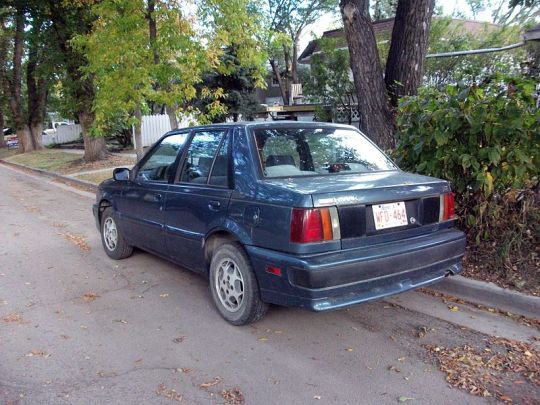
wikimedia commons

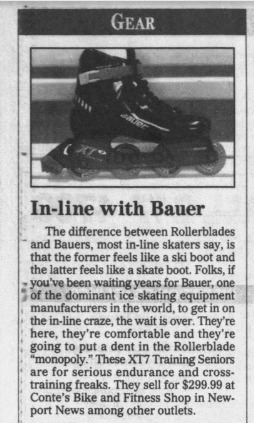
three.hundred.dollar.rollerblades, I mean Bauers.

I'm with S.M, I'd be mad as hell if I didn't have my Cathy. I've actually begun re-reading the strip again recently.


via GIPHY
OH MY GOD IT'S HAPPENING. The fist time jump in Funky Winkerbean history.


So, finally in the early Summer of 1992, the kids at Westview High finally graduate, and the strip jumps four years later to see them as straight out of college adults -- thus making them graduate in 1988 instead of 1992. Got that?

Too Legit to Quit? Really? How do you do, fellow kids?

This was part of some strange celebrity news insert I guess Daily Press did back then. This was here too:


welp, here's a kid playing with cockroaches with Ross Perot's face on it.
Facebook | Etsy | Retail History Blog | Twitter | YouTube Playlist | Random Post | Ko-fi donation | instagram @thelastvcr | tik tok @ saleintothe90s
#daily press#old newspapers#ross perot#cockroaches#children's palace#hampton virginia#funky winkerbean#isuzu#sidney reso#bill kurtis#little ceasars#pizza pizza#phar mor#walmart
7 notes
·
View notes
Text
Fruits Basket Reboot: Analytical Overview of the Anime
Fruits Basket’s reboot is one of most successful anime reboots since it has:
Amazing story that celebrates human weakness, digs into the depths of human identity & doesn’t shy away from depicting child trauma & abuse. Teaches the values of letting go & walking forward.
The author’s blessing, nostalgia factor from loyal fanbase.
Fixed scheduled 3 season comeback with 63 eps in total planned from the very beginning.
Finished source material with its ending approved by manga fans.
Anime follows the official manga ending.
The “slice of life/shojo” genre doesn’t need budget for fight scenes or big scale realistic animation for its lore.
All these factors contributed to its success, however, this doesn't mean the anime was a masterpiece. It is very good but had issues aren’t in the writing, but rather in the format, overall vision & its effect on characters’ depths.
1. Format:
a. ( Is Fruits Basket an episodic anime or a plot-driving story?)
-The anime couldn’t decide how to adapt the manga content, should it follow it literally & combine two chapters together each time, or take the core plot & drive it by character, or focus on its vision or what? they KNOW that can’t adapt everything. They have 63 eps in total so they have good number of eps to do any choice. However, since the anime is advertised as “ a faithful adaptation” they wanted to cement this announcement in se01 & chose “character of the day” format. Once, the manga fans are assured & hooked, they can drive the rest wherever.
-Se02 was slightly less episodic (minus the beach arc which had perfect pacing). Afterwards, the yuki content was approached similarly to se1 but centered around “ episodic themes”. Lots of characters arcs are pushed to se3 to keep the “mother” theme of se2. that’s why all eps ended happily minus few eps such as tohru’s nightmare ending in isuzu’s ep.
-Se03 is where the anime really had the biggest issues & couldn’t decided between keeping themes or rolling like a true well-written drama-infused story. Thus we see them trying to keep the episodic themes as long as possible in 5 eps & once ep 6 starts & they can no longer label a flowing plot into themes, they rolled into the climax. The entirety of tohru’s neglected issues outside of her role as a mother was condensed in one ep via audio narration, since ep 7 should drive akito into the climax spot, ep 8 is kyo’s & ep 9 is female antagonist vs female protagonist clash. The rest of the eps focus around wrapping the growth arcs of kyo, akito, yuki & tohru.
I wish they kept the episodic forma for se01 only. Se01 is episodic by design since you can’t maneuver around character introduction, but they should’ve let season 2 & 3 flow smoothly without imposing episodic themes that a junior high schooler could detect, simply because the theme will choose which character fits this ep & which must be cut. Hardly a smart decision for a drama-focused story. Example: Se02 post-beach arc, being “mother tohru” themed meant the cut content of any “teenage girl tohru content”, focusing only on her role as a mother & shoving the rest of “tohru” into the unbelievably packed se03.
b. ( How the seasons are divided & which one is best?)
Lots of fans believed that: se1 (kyo focus), se2 (yuki focus), se3 (tohru focus), I don’t think this is the correct official anime format at all, but rather the fans wishful thinking, here’s why:
se01 isn’t kyo’s focus at all. Kyo has ONE focused ep each season: se01:ep24, se3: ep9, & se03: ep8. He gets more screen time in se03 to deal with the aftermath of ep8 & to mark his growth & close his arc. But, yuki had more focused eps in se01 than kyo. Example, se01, ep 12, yuki tells the audience abt his dream of new friends, home & new self, sth he achieved gradually ever since that ep ended, thus, Kisa’s ep is a yuki centered ep as well as it marked the beginning of (a) “mother tohru” issues, (b) him deciding to join student council & get out of his comfort zone which is the beginning of “ new yuki”.
se2 is indeed a yuki centered season.
se03 is not a tohru’s focus at all, we still had (akito, shigure, kyo, kureno, momiji, isuzi, haru, machi, motoko, & more yuki) to start or finish their arcs & it is 13 eps only. tho, Tohru had a self-focused role at last which is good.
-I believe the following format better describes the anime’s seasons’ division since it is driven by themes:
se01: Life teachings for the youngsters, due to the direct format of advise given by mother kyoko thro her daughter to the characters/ audience.
se02: Life teachings thro a coming of age story. The trio are struggling to choose a future, afraid & burdened by their trauma’s. Yuki with the help of “mother tohru” , leaves the nest “youngster stage” & sets his foot into the future & struggles to: have fiends, express himself, face his parents, be honest with himself, form an identity & understand himself.
se03: Life teachings of mature issues to those who have already chosen wrong once or twice. bigger issues are presented such as: guilt, death, trauma, extreme self-loath, self-destructive tendencies (kyo), grief, lack of self-esteem, refusing to let go of the past, abandonment issues, constructed polite girl identity with false happy mask (tohru), superiority complex, false forced identity, sins & misdeeds (akito), other themes such as adultery, manipulation, passiveness & enabling can fit the other characters.
So, naturally, season 3 is the richest in content, extremely entertaining story-focused, plot-driven, multi characters depth, plethora of themes, issues & variety of fascinating character writing to distinguish between various arcs & wrap ups. Honestly, se03 carries the whole success since it IS the story of Fruits Basket ( a basket of different fruits & we get to hear/see them all, including the rice-cake!). Still, se03 suffered from the issues of pacing & format I mentioned above, plus condensed content due to short number of eps dedicated to 12 characters.
2. Overall Vision:
Tohru being the main protagonist carries the story’s vision, however, I think Taklaya-san wanted the vision to expand to all her characters. I duno abt the author’s true vision since I haven’t read the manga, but if I were to guess based on the overall story: it is “the acceptance of human weakness”. Yuki isn't the perfect prince, tohru isn't the angelic mom, kyo isn't the horrible monster. These assumptions are the OTHER characters’ perspective of them. Not their true identity or reality. We later even learn that the abusive akito herself, chose a healthier identity, the atoned family head. However, in the anime, characters’ weakness isn’t the center of the anime’s vision, rather its vision is abt the “nurturing effects of the mother figure”, which is supported by the writing as well, but shouldn't be the core driving plot. The anime is more centered around mothers & more narrowly guided. The characters’ weaknesses takes a second seat until the focus on the mother role is over. This does not affect tohru only, but all characters including yuki himself.
-Tohru being the female protagonist shouldn’t be angelic as this contradicts the core theme, thus tohru is given her own set of (human aspects): trauma, frustrating character traits, faulty coping mechanism: the fake happy mask. Her role as yuki’s mother is only ONE part of her, as big as it is his life & as huge as it is from his perspective. It should NOT be what the audience can only see & feel from tohru. If it is, then Tohru is forever the 16 year-old mother of her peers, sth a normal teenager shouldn't, contradicting the basic existence of the human aspects mentioned above.
a. How does the overall vision being focused on “tohru’s motherly role” affect characters’ depths?
-For Tohru: In the anime, tohru being yuki’s mother lasted for 2 seasons, during that time, we are ONLY allowed to see HER from HIS perspective. Everything abt her human weakness is either vaguely hinted “ few scenes here & there” or pushed to se03. In se01 & 2, tohru is only allowed to act as a “teenage girl” in front of two male characters: (kyo & momiji):
How is tohru depicted in front of kyo & momiji? If you re-watch the anime, once tohru is around these two, her character is very different & she stops giving advice & instead “listen” to them. She is shown more lively & drawn younger & girly, asking more than talking, receiving advice, they both look at her as a normal girl with burdens on her shoulder rather than “savior/care taker”. Kyo complains to her few times abt that & calls her out on her self-denying antics, momoji takes a different approach & subtly provides chances for her to be a “teenage girl”: going to a hot spring & vacation. She opens up to kyo slowly in all her scenes with him, but while she doesn't open up to momiji, she allows herself to show vulnerability & throw her mask a bit in front of him (se01, ep12: she listened to his talk abt his mom, related to him, cried & hugged him with NO advice even tho she didnt tell him abt her mom), se02, she listened to his talk abt his sister, related to him, cried & gave NO advice even tho she didnt tell him she thought abt her mom).
The anime’s heavy focus on her “motherly”side, contradicts showing her as vulnerable & traumatized, hence her backstory lasted for 4 minutes in her own ep, se03, ep6. Later when she faces akito, tohru’s growth kicks in & she starts relating to her issues of abandonment but all this growth came from those 4 minutes of backstory in ep6. In ep9, in front of akito, tohru was depicted just like how she is depicted in all yuki centered eps, ( giving an advice, smiling, a hallow of light around her, the sun rises, the rain stops & she shines her kindness to heal the wounds).
-For Yuki: In the anime, Yuki is shown seeking a mother & all the right monologues & issues are perfectly presented. However, his weakness isn’t only wanting a mother!! yuki is depicted as a prince by others, so a huge part of his growth is to leave the princely persona behind, which is sth that was not focused on in the anime. Outside of his issues on viewing tohru as a mother & wanting friends, yuki continued to be depicted as prince & wasn't much allowed the freedom of being “a normal teenage boy”. Machi narrated that part of his growth, motoko too, but it wasnt depicted much on screen & yuki continued to have dashing bubbles, sparkles, hair flowing on wind & extreme focus on beautiful face. Him becoming a dynamic character outside of his “finishing my tohru-mother confession to my friend” is very short lived. This would’ve easily been fixed if less attention was given to his “mom tohru” phase. He is more than “I used to look at tohru as my mom”.
-For kyo: In the anime, kyo never looked at tohru as a mom, hence from the beginning kyo didn’t fit the overall vision. Hence, all his issues are pushed into se03 when tohru’s “mom role” is finished. There is a reason we have ONE kyo centered ep in se1 & 2. it IS contradicting the current tohru-image of being a mom. Also, kyo’s thoughts are blocked completely for dramatic purposes but he didnt need to be absent from tons of eps which he was, even his growth ever since se01 finale is very subtle in order to not derive from tohru’s image as a mom. We have some scenes of kyo & tohru interacting, but they should be sparse se01, ep 23 (soup ep) or se02, ep2, or short scenes such kyoto scene or tohru’s worried abt her grandpa scene in se2, ep14. Most of kyo’s & tohru’s scenes aren’t solely romantic in their nature but they provide in depth peek into their true personality & identity as humans. With her kyo isn’t angry or annoyed & with him tohru isn’t bubbly with the “I’m okay” mask.
Side Notes:
There is no doubt that the anime was made with respect & love to the source material & the author. I can see this clearly & I don’t deny it at all. This isn’t meant to ridicule them at all. I respect them all plenty.
There is no doubt that the anime team were trying their best & if you like everything, then good for you, if you like some parts & don’t agree with others, then that’s fine. Criticizing is a form of loving, too. Just be respectful.
Preferences, tastes, visions, & outlooks, all differ from one human to another. This is normal & healthy.
The director or decision maker in the anime having different vision from the author is fine, too. After all, he’s a different person. His perspective & understanding of her characters is different. Disagreeing with him is fine. All medium of art are exposed to the audience perspective. I disagree with him on lots of creative decisions such as reliance on monologues, wide shots on intense moments, lack of zoom on facial expressions, most parallel scenes are very in the nose, need for exaggerated drama & over dramatic drawing of tohru & akito at times.
You can even differ with the writer herself on some parts of her writing, that’s fine, too.
I enjoyed this anime lots, it helped me make new friends, discuss lots of fascinating content, & practiced writing short critical reviews, which is sth I’ve missed from my college days!
I love the writing for the main male characters: Yuki & Kyo. I love their arcs so much! Yuki got the best focus on his core issues. Kyo, in particular surprised me as I used to think, due to the minimum content on him, that he’s only the secondary rival of the main male protagonist. But kyo’s story turned out fascinating & very psychological informed.
Still, the anime is lacking to me for its depiction & presentation of women. The main female characters (Tohru & akito) are lacking realistic depiction of their core issues & time dedicated to that. The focus on tohru’s mom role steals from realistic existence as a character on her own right. Akito is a villain for so long & her atonement is quick & her love story is quicker. Both females didn’t get to tell us their traumatic backstory in detail like the boys & they didn’t have enough focus on their human side.
Altho kyo had (1) way less screen time than yuki or even tohru, (2) his true backstory was only revealed in the climax, (3) his inner thoughts were blocked for suspense, he was written wearing his emotions on his sleeve from ep1, so, we grew to feel for him & dreaded what could’ve broken such endearing boy, hence, once it was shown we understood the psychological trauma that destroyed him. One third of the puzzle of his story was revealed each season gradually. (1) se01 (true form), (2) se02 (his bet with akito, knowing kyoko & loving tohru), (3) se03 (His whole backstory including the abusive father).
I wouldn’t say, I wish tohru was given the (yuki treatment) cuz then we’ll need more than 13 eps for se03, I just wished her story & emotions to at least be given the (kyo treatment): Divided into clear thirds (parts).
The anime is a lovely treat that I can recommend to lots of ppl with ease. You dont have to be into shojo to get into it, but it’ll undoubtedly trick you into its subtle main love story that subvert most shojo tropes. The other love stories are good as well, there’s a type of love for every fan!
There’s a number of platonic friendships which is very refreshing!
My Final Verdict of the anime: Very Endearing as it tugs at my heart!
#Fruits Basket#Anime Only#overall impression#analytical overview#tried paper#Recommended anime for sure!#Will read the manga!#se03 sells the manga good!
95 notes
·
View notes
